Vita Dulcis: fear and desire in the Roman Empire
Why are we so fascinated with the ancient world?

I grew up with my paternal grandmother and her (unmarried) partner, whom I called “zio” (uncle) Tino, but who was really a grandfather to me, if not actually a father. Zio Tino introduced me to Greek and especially Roman culture, by telling me stories from antiquity and giving me books wonderfully illustrated with scenes from Greco-Roman lore.
I thought that early fascination had definitely abated once I developed my interest for science—also, incidentally, fostered by zio Tino—and embarked on my first academic career as an evolutionary biologist. But then mid-life crisis hit and I rediscovered a passion for philosophy (that one was at least partially the result of a wonderfully engaging high school teacher, Enrica Chiaromonte).
Finally, a number of years ago, I discovered Stoicism and the whole notion of practical philosophy. With it, my fascination with all things Greco-Roman came back with a vengeance, and now, nearing the end of my sixth decade, I find myself mostly thinking and writing about that lost world and its relevance to contemporary life. Because it is relevant, very much so. But why, exactly? What is it that makes not just the philosophy of Socrates, Cicero, and Epictetus, but the history of Alcibiades, Julius Caesar, and Hadrian so germane to the superficially wildly different life of the 21st century? Why do we care about these long gone people?
That is the fundamental question asked by an exhibit I just saw at the Palazzo delle Esposizioni in Rome, entitled Vita Dulcis: fear and desire in the Roman Empire, put together by the Italian artist Francesco Vezzoli in collaboration with Stéphane Verger, director of the National Roman Museum. It is a stunning show that explores deep issues concerning human existence and meaning by combining ancient artifacts, contemporary art, and a series of clips from “sword and sandals” movies, i.e., movies set in ancient Rome.
Rotunda: ancient and modern celebrities
The exhibit unfolded by means of seven thematic rooms and a central rotunda connecting them. The rotunda featured a single piece by Vezzoli, consisting in six “portraits of divas,” each made of the body of a classical sculpture (the Venus from Knidos, a dancing Venus, the Medici Venus, Vibia Sabina [emperor Hadrian’s wife], the Callipygian Venus, and the Aphrodite Sosandra). The sculptures had their faces replaced by those of modern divas: Sharon Stone, Michelle Williams, Anita Ekberg, Valentina Cortese, Jeanne Moreau, and Princess Caroline of Hannover. Moreover, in each case the eyes were those of Vezzoli’s mother.
The idea was to highlight the notion that celebrities, and particularly women celebrities, have always been a feature of western civilization, one strong hint that there isn’t anything radically new under the sun when it comes to human behavior and mores. But why women, especially? Because the attitude of society toward half of the human race has been—and still, to some extent is—more than a bit ambiguous, as Vezzoli then explored further in one of the thematic rooms discussed below.
This part of Vita Dulcis reminded me of another exhibit that mixed ancient sculptures and modern art that I saw at the splendid Archeological Museum in Naples a few years ago. It featured statues of superheroes (Batman, Spider-Man, and so forth) completely intermingled with those of ancient heroes (Hercules, Apollo, etc.). It was the male counterpart of the Vita Dulcis rotunda, just as powerful a reminder of our obsession with extraordinary human beings, whether they be beautiful women or muscular men.
I-Para bellum: on war
The first thematic room’s title was inspired by the Latin author Vegetius (4th century CE): Si vis pacem, para bellum, that is, “If you want peace, prepare for war.”
War is one of human universals, and apparently it isn’t about to go away, despite the rather optimistic take of some recent authors like Steven Pinker. It is, in fact, deeply sobering to see how the exact same attitudes the ancients had about war still persist today, including the enacting of behaviors that would under normal circumstances be considered horrifying and profoundly immoral.
One such behavior is represented by the composition of Achilles and Penthesilea (see photo below), referring to a scene of the Trojan War. Penthesilea was the Amazon Queen who was slayed in battle by Achilles, the Greek “hero.” She then becomes a victim of necrophilia on the part of Achilles when he falls in love with her after her death.
That war has, for some puzzling reason, always made men “great” is attested not just by the well-known nickname of Alexander of Macedonia, but also by the custom of leaders like the Roman emperor Domitian to be represented in military garb and in “heroic” pose (same photo below).
One of the two movies from which clips were playing in the background was, of course, Ridley Scott’s Gladiator, with its not so subtle representation of violence both within and without the gladiatorial arena.
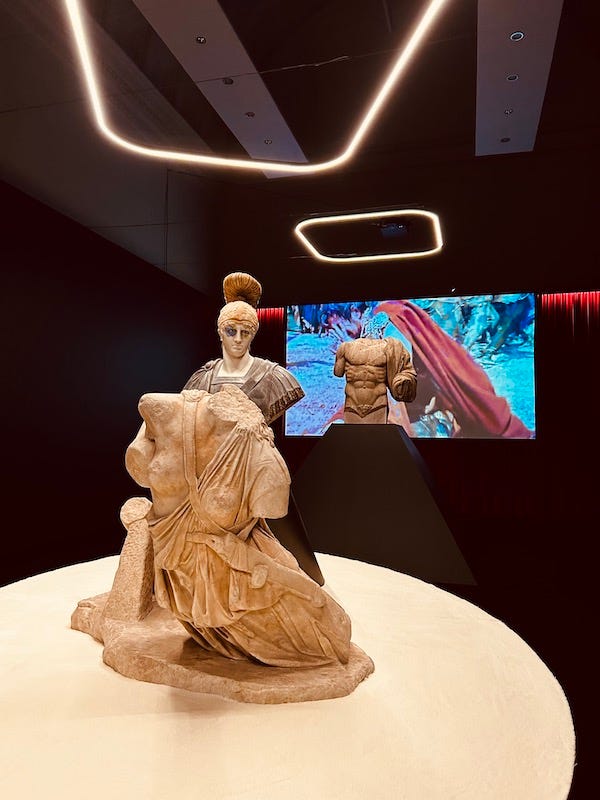
II-Animula vagula blandula: on homosexuality
The title of the second thematic room comes from the first line of a poem found in the Historia Augusta and attributed to the dying emperor Hadrian:
Animula vagula blandula
Hospes comesque corporis
Quae nunc abibis in loca?
Pallidula rigida nudula
Nec ut soles dabis iocos
Poor little, wandering, charming soul
Guest and companion of my body,
What place will you go to now?
Pale, stiff, naked little thing,
Nor will you be making jokes as you always do.
The reference is to Antinous, the youth loved by Hadrian to whom the emperor devoted an empire-wide cult after his lover’s death.
The room also features scenes from the 1976 movie Sebastiane, about the life of St. Sebastian. It was highly controversial when it came out because it was based on an apocryphal account of the life of the saint as a Roman legionnaire, an account accompanied by a number of scenes depicting homosexuality among Roman soldiers.
Homosexuality, despite recent advances, is still a highly controversial subject for many people, and when the controversy is not about gays and lesbians then it is about the next category of “deviants,” like trans people. That is because we have always had trouble accepting what appears to be different and unusual, another human universal being xenophobia.
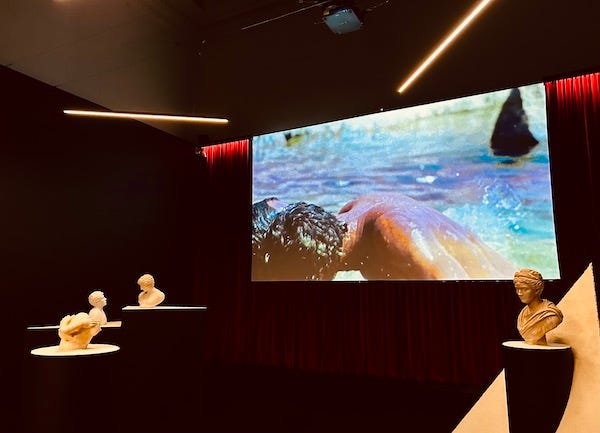
III-Dux femina facti: on women
Roman society—like pretty much all ancient and most more recent societies—was patriarchal, with women relegated to a secondary role. Still, things were better for women in Rome, especially during the imperial period, than, say, in much of Greece (the exception being, perhaps surprisingly, Sparta). But still.
This section therefore explored another recurring and still modern theme: sexism. (I don’t call it misogyny, as it is currently the fashion, because the latter means hatred of women, which doesn’t seem to be the case in most situations we are discussing.)
Patriarchy, though, didn’t mean that there were no powerful women, or that some women couldn’t inspire not only respect, but even fear. That is why one of the archeological pieces showcased was a head of Medusa from the first century CE, and why both featured movies were about Cleopatra, the Egyptian queen (of Greco-Macedonian descent) who developed complex personal and political relationships with both Julius Caesar and Mark Anthony.
The phrase Dux femina facti means “the woman guides the enterprise” and is from Virgil’s Aeneid. The reference is to Dido, the legendary first queen of Carthage, the city that eventually became Rome’s chief rival for the control of the Mediterranean. Virgil was describing how Dido led the charge against a tyrant, a very unusual role for a woman at the time, so the phrase became a way to refer to women characterized by a strong personality and unusual moral stature.
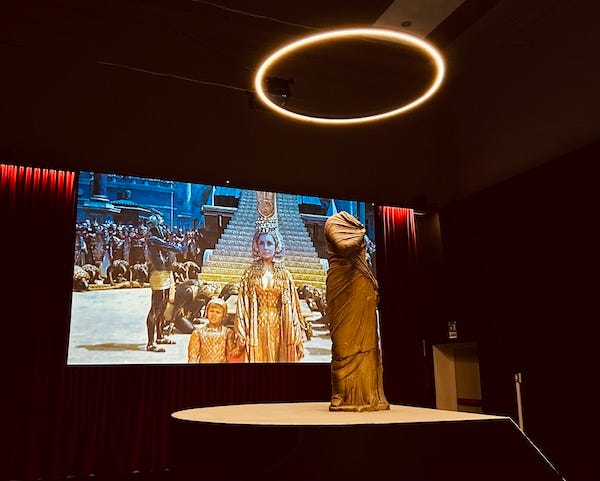
IV-Certa omnibus: on death and the afterlife
Certa omnibus, certain for everyone, was a common Roman motto found on meridians and referring to the fact that death is coming for us all. This is, of course, a major Stoic and Epicurean theme. For Seneca, the point of philosophy is to prepare us for that last test of character, the one we cannot escape no matter how lucky we’ve been throughout our life.
The set up of the room here was stunning: 47 tombstones (see photo below) lined on both sides of a long corridor and pointing to a screen where we could see scenes from the 1914 silent movie “Cabiria,” directed by Giovanni Pastrone and with inter-titles by Gabriele D’Annunzio, at that time referred to as the poet (an expression that before had only been used for Dante).
The Romans believed in an afterlife, even though neither the Stoics nor the Epicureans did. In fact, the Romans developed a cult of the ancestors, as well as one of the dead more generally. This was reinforced by the practice of deifying many emperors after their death, which led Seneca to write a satirical piece entitled Apocolocyntosis, or The Pumpkinification of (the Divine) Claudius, in which he made fun not only of the emperor who sent him into exile, but more broadly of the very practice of apotheosis, i.e., of pretending that the dead emperor was now a member of the divine congregation.

V-Ridentem dicere verum: on humor and truth
The fifth thematic room was dedicated to humor and satire, one of the most powerful tools to express political dissent, amply used by the ancient Romans as well as by modern ones.
The title comes from a phrase by Horace: Ridentem dicere verum: quid vetat? To tell the truth while laughing: what prohibits it? The answer of course is the authorities, who do not usually take kindly when people speak truth to power, even more so when making fun of power.
Again we contemplate a topic that is very much on the mind of us denizens of the 21st century: the limits of free speech and the power of censorship—whether enforced by the government or by social media hordes.
Both movies clipped here were entitled Satyricon, both came out in 1969, and both where inspired by the immortal poem by the same title authored by the late first century author Gaius Petronius. The first movie is the well known, yet difficult to make sense of, production by Federico Fellini. But it was the second, more approachable one, that most vividly brought the point to bear for me. Directed by Gian Luigi Polidoro it featured the beloved Ugo Tognazzi, a comic actor that was ubiquitous on Italian screens from the 1950s through the 1980s. You can see him clearly in the photo below.
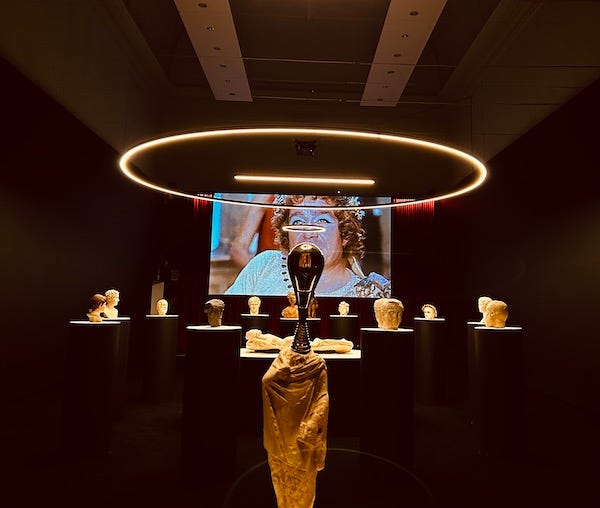
VI-Ubi potentia regnat: on power
The next to the last thematic room’s title was derived from the Latin motto: Ius rationis abest, ubi saeva potentia regnat, which means “Where force reigns, reason does not exist.”
The relationship between power and reason has always been a fraught one. Instances were reason and wisdom have guided power are few and far between, despite almost everyone who reaches power protesting that he is of course just and wise.
The room presented the busts of a number of Roman emperors: Domitian, Hadrian, Marcus Aurelius, Septimius Severus, and Constans II, personifying different degrees of wisdom during the exercise of power (Marcus arguably the best, Domitian the worst). Interestingly, the heads of both Marcus and Domitian were drafted on female torsos, perhaps a reference back to the theme of room III.
The most interesting bit for me was one of the two movies from which clips were shown here: My Son Nero, 1956, starring the wonderful Italian comic actor Alberto Sordi as a mischievous and insecure Nero, accompanied by the beautiful French actress Brigitte Bardot (playing Nero’s wife, Poppea) and by the great Vittorio de Sica (playing Seneca). Can you tell next to whose tombstone does Nero stand in the photo below?
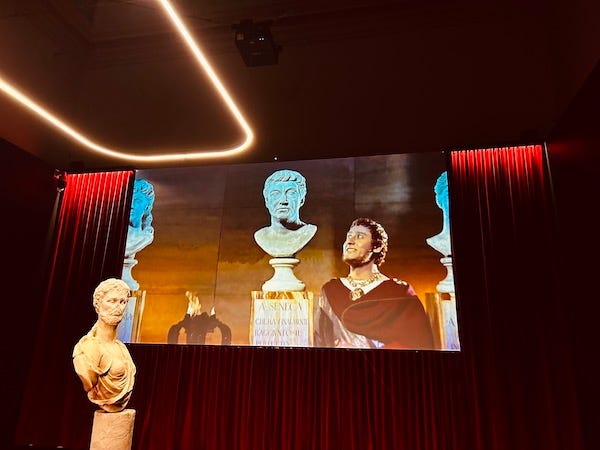
VII-Mixtura dementia: on madness and creativity
The last room is, as the Latin title declares, a mixture of dementia, featuring a large number of fragments of all sorts from the National Roman Museum collections, the theme being the perennial one of the relationship between madness and creativity.
By far the most interesting bit here was the “movie.” It’s actually a spoof trailer for a movie that was never made. It was produced by the artist, Francesco Vezzoli, and presented at the 51st Venice Biennial in 2005. Allegedly, the trailer is for a remake of a movie about the mad emperor Caligula, scripted by Gore Vidal (who appears at the beginning of it), and starring Milla Jovovich, Benicio Del Toro, Courtney Love, Barbara Bouchet, and Adriana Asti. Apparently Vezzoli managed to convince this incredible ensemble to gather together in a Beverly Hill villa and have a laugh while making fun of Hollywood’s fascination with ancient Rome. You can watch the full trailer here:
Gore Vidal really did write (and then disavowed) the script for a movie on Caligula, which was made in 1979 by Tinto Brass, starring Malcolm McDowell in the title role, alongside Teresa Ann Savoy, Helen Mirren, Peter O’Toole, John Steiner, and John Gielgud, production by Penthouse founder Bob Guccione. I haven’t seen it…
<<>>
Vezzoli and Verger’s Vita Dulcis is a tour de force of ancient and modern art and ultimately—as good art or philosophy ought to—raises more questions than it answers. These are questions about the constants of the human condition, aspects of our existence that have not changed much, in the general outlines, since Roman times, and that were already very old by then.
The chief reason, for me at least, to study not just the Greco-Roman philosophers, but classical history, art, and literature more broadly, is precisely because those people were already struggling with the very same issues we still struggle with: war, mortality, power, diversity, the cult of celebrity, and the subversiveness of humor.
That is why when Petrarch rediscovered Cicero and the classics, thus giving birth to the Renaissance, he started something that affected history and culture for centuries, and which continues to this day. If you cannot attend Vita Dulcis do yourself a favor and start reading the philosophers and writers mentioned in it. You will not regret it.



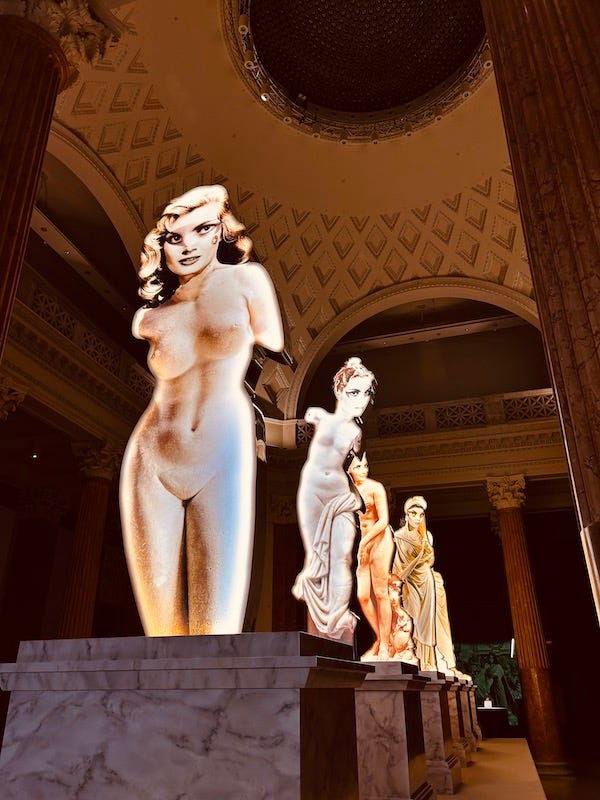
Et memento vivere?
You have had a sweet life, Massimo Pigliucci, and you add to ours, too. Thanks. (To see the most erotic/pornographic bits of that trailer, it turns out you have to use the pause button.)